Leonardo da Vinci / Maestro Leonardo
page 2
| x |
|
|
|
|
|
|
|
|
|
|
|
|
|
|
|
|
|
|
|
|
|
|
|
|
|
|
|
|
|
|
|
|
|
|
|
|
|
|
|
|
|
|
|
|
|
|
|
|
|
|
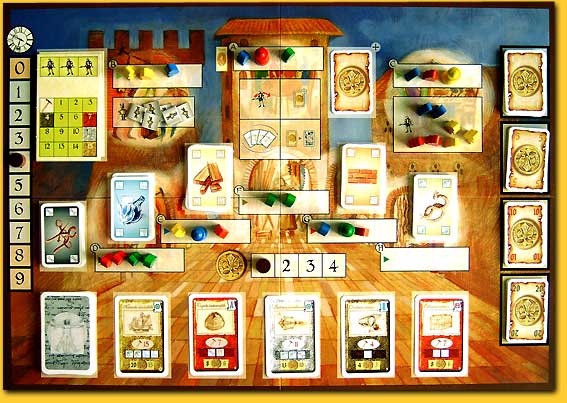 |
|
|
|
|
|
|
|
|
|
|
|
|
|
|
|
|
|
|
|
|
|
|
|
|
|
|
|
|
|
|
|
|
|
|
|
|
|
|
|
|
|
|
|
|
|
|
|
|
|
|
|
|
|
|
|
| During the last phase of a round the laboratories are worked, and the invention disc on it adjusted accordingly to the amount of pupils, robots, and the presence of the master. The pupils and the master return to the players stock, the robots stays there. When the invention discs has reached the necessary amount of weeks for the invention, the owning player hands in the materials and gets the amount of the specific invention card. The card itself can be claimed; this could help a player in future inventions of the same kind of five possible symbols on a card; for each matching symbol he reduces his next research with two weeks. |
|
|
|
| x |
|
|
|
|
|
|
|
|
|
|
|
|
|
|
|
|
|
|
|
|
|
|
|
|
|
|
|
|
|
|
|
|
|
|
|
|
|
|
|
|
|
|
|
|
|
|
|
|
|
|
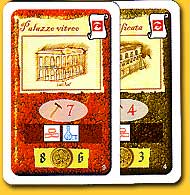 |
If there is more than one player who has completed the same invention, they both get the full amount of money, but the card goes to the player who bids the highest amount of money in a single blind bid. Players who work on the same (now completed by another player) invention but did not complete it have to announce this, and when they do complete it in a later round, get less money and in any case have to dispense with the card.
At the start of round eight the city is off limits; in two smaller rounds only the laboratories are worked and inventions started or completed with previous collected materials.
|
|
|
|
 |
|
|
|
|
|
|
|
|
|
|
|
|
|
|
|
|
|
|
|
|
|
|
|
|
|
|
|
|
|
|
|
|
|
|
|
|
|
|
|
|
|
|
|
|
|
|
| It is difficult to be in each and every location and have a majority there. Because of the special placement rules planned majorities may get lost and a player will have to calculate hard where he wants to place his tokens, and how much. This adds to the frustration factor of the game, and it may lead to a player fall behind a round because he lacks the necessary materials for starting a new invention. |
|
|
|
| x |
|
|
|
|
|
|
|
|
|
|
|
|
|
|
|
|
|
|
|
|
|
|
|
|
|
|
|
|
|
|
|
|
|
|
|
|
|
|
|
|
|
|
|
|
|
|
|
|
|
|
| The game has a considerable playing time, but it fails to to run smoothly, and then the end already is announced in round eight. The superfluous and needless complex mixing of the stack of invention cards at the start of the game only gets depleted by half. The inventions on the cards are not by Leonardo da Vinci, but from one of the authors; neatly done, but not to be taken very seriously. If this game was meant as a tribute to master Leonardo, it has failed. |
|
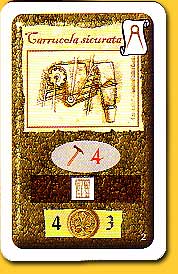 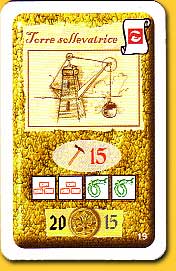 |
| x |
|
|
|
|
|
|
|
|
|
|
|
|
|
|
|
|
|
|
|
|
|
|
|
|
|
|
|
|
|
|
|
|
|
|
|
|
|
|
|
|
|
|
|
|
|
|
|
|
|
|
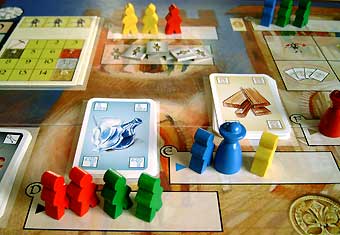 |
This also goes for the barely visible sketch of a town acting as a background of the playing area. It lacks the necessary atmosphere and detail and should have gotten more attention to support the feel of the game. As the game looks now, it has a rather dull, abstract and dry look, that unfortunately is noticeable in gameplay too. Further, the last two rounds feel very artificial; there must be an other and more elegant way to end a game. |
|
|
|
| x |
|
|
|
|
|
|
|
|
|
|
|
|
|
|
|
|
|
|
|
|
|
|
|
|
|
|
|
|
|
|
|
|
|
|
|
|
|
|
|
|
|
|
|
|
|
|
|
|
|
|
|
The frustration to get the right materials might be the reason that the authors came up with a variant, where there is an additional and last location in the town: a market, where players can trade material cards against other present cards.
Especially towards the end of the game it can slow down because each player wants to optimize his move. When after a long silence doubt takes over, one of the other players might ask: ‘Achi tocca (who’s turn is it)?’ And this certainly cannot be the intention of the collective of authors that took this name!
© 2006 Richard van Vugt
|
|
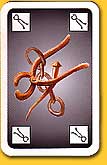 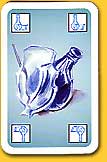 |
Leonardo da Vinci, Acchittocca, daVinci Games, 2006 - 2 to 5 players, 12 years and up, 60 to 90 minutes
|
|
|
|
  |
 |
|
|
|
|
|
|
|
|
|
|
|
|
|
|
|
|
|
|
|
|
|
|
|
|
|
|
|
|
|
|
|
|
|
|
|
|
|
|
  |
|
|
|
|
|
|
|
|
|
|
|
|
|
|
|
|
|
|
|
|
|
|
|
|
|
|
|
|
|
|
|
|
|
|
|
|
|
|
  |
|
|
|
|
|
|
|
|
|
|
|
|
|
|
|
|
|
|
|
|
|
|
|
|
|
|
|
|
|
|
|
|
|
|
|
|
|
|
  |
|
|
|
|
|
|
|
|
|
|
|
|
|
|
|
|
|
|
|
|
|
|
|
|
|
|
|
|
|
|
|
|
|
|
|
|
|
|
  |
|
|
|
|
|
|
|
|
|
|
|
|
|
|
|
|
|
|
|
|
|
|
|
|
|
|
|
|
|
|
|
|
|
|
|
|
|
|
  |
|
|
|
|
|
|
|
|
|
|
|
|
|
|
|
|
|
|
|
|
|
|
|
|
|
|
|
|
|
|
|
|
|
|
|
|
|
|
| x |
|
|
|
|
|
|
|
|
|
|
|
|
|
|
|
|
|
|
|
|
|
|
|
|
|
|
|
|
|
|
|
|
|
|
|
|
|
|
|
|
|
|
|
|
|
|
|
|
|
|
| x |
|
|
|
|
|
|
|
|
|
|
|
|
|
|
|
|
|
|
|
|
|
|
|
|
|
|
|
|
|
|
|
|
|
|
|
|
|
|
|
|
|
|
|
|
|
|
|
|
|
|
 |
|
|
|
|
|
|
|
|
|
|
|
|
|
|
|
|
|
|
|
|
|
|
|
|
|
|
|
|
|
|
|
|
|
|
|
|
|
|
|
|
|
|
|
|
|
|
 |
|
|
|
|
|
|
|
|
|
|
|
|
|
|
|
|
|
|
|
|
|
|
|
|
|
|
|
|
|
|
|
|
|
|
|
|
|
|
|
|
|
|
|
|
|
|
 |
|
|
|
|
|
|
|
|
|
|
|
|
|
|
|
|
|
|
|
|
|
|
|
|
|
|
|
|
|
|
|
|
|
|
|
|
|
|
|
|
|
|
|
|
|
|
| x |
|
|
|
|
|
|
|
|
|
|
|
|
|
|
|
|
|
|
|
|
|
|
|
|
|
|
|
|
|
|
|
|
|
|
|
|
|
|
|
|
|
|
|
|
|
|
|
|
|
|
 |
|
|
|
|
|
|
|
|
|
|
|
|
|
|
|
|
|
|
|
|
|
|
|
|
|
|
|
|
|
|
|
|
|
|
|
|
|
|
 |
|
|
|
|
|
|
|
|
|
|
|
|
|
|
|
|
|
|
|
|
|
|
|
|
|
|
|
|
|
|
|
|
|
|
|
|
|
|
|
|